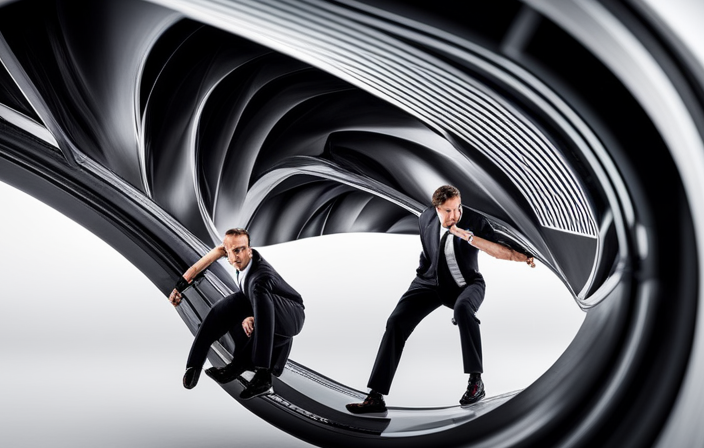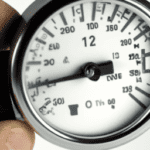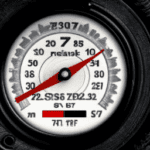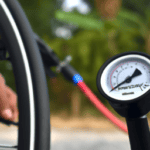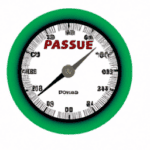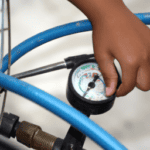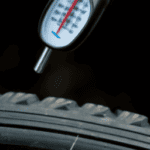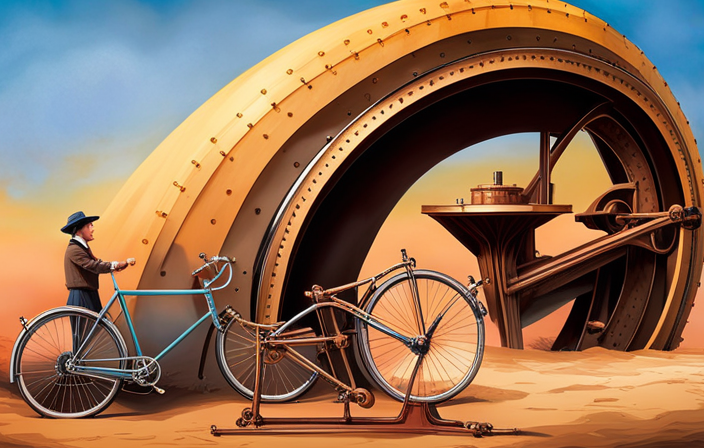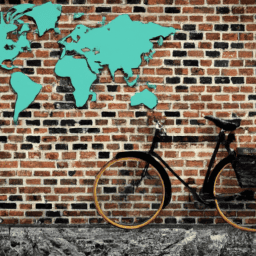“Like the saying goes, ‘The right amount of air can make or break your ride.’ With bicycle tires, ensuring proper inflation is essential for achieving peak performance and safety.”
In this article, I will delve into the importance of maintaining the correct tire pressure, how to determine the right amount of air using pressure ratings and gauges, and the effects of incorrect inflation.
Whether you’re a casual rider or a seasoned cyclist, understanding the ideal tire pressure will ensure a smooth and enjoyable journey.
Key Takeaways
- Proper tire pressure ensures better grip on the road, reducing accidents.
- Different types of bicycles may require different pressure levels.
- Recommended PSI varies depending on riding conditions such as road biking, mountain biking, commuting, touring, and racing.
- Maintaining proper tire pressure is important for enhanced safety, performance, efficiency, and comfort.
The Importance of Proper Tire Inflation
Proper tire inflation is crucial for maintaining optimal bicycle performance.
Proper tire maintenance includes regularly checking and adjusting tire pressure to ensure it falls within the recommended range.
By keeping the tires properly inflated, cyclists can experience several benefits.
Firstly, it improves the overall efficiency of the bike, making it easier to pedal and reducing rolling resistance. This means less effort is required to ride, allowing for longer distances and faster speeds.
Additionally, proper tire inflation ensures better control and handling, especially when cornering or navigating uneven terrain.
Furthermore, it helps prevent flats and reduces the risk of tire damage.
Understanding tire pressure ratings is essential to achieving the right inflation level.
By following the recommended guidelines, cyclists can maximize their riding experience while minimizing the chances of tire-related issues.
Understanding Tire Pressure Ratings
To understand the tire pressure ratings, you’ll need to know the recommended psi for your bike’s tires. Calculating optimal tire pressure is crucial for a smooth and efficient ride. The recommended psi is usually imprinted on the side of the tire or mentioned in the bike’s manual.
However, it is important to note that the optimal tire pressure may vary depending on factors such as rider weight, terrain, and riding style. Heavier riders may require higher tire pressure to support their weight, while lighter riders may need lower pressure for a more comfortable ride. Similarly, rough terrains may necessitate higher pressure for better stability, whereas smoother surfaces may allow for slightly lower pressure.
Understanding these factors will help you determine the appropriate tire pressure for your bike. Moving on to using a tire pressure gauge, it is essential to accurately measure and maintain the recommended pressure.
Using a Tire Pressure Gauge
You can easily check your tire pressure by using a gauge. It is important to regularly check and maintain the correct tire pressure to ensure optimal performance and safety while riding.
Here are some key points to consider when using a tire pressure gauge:
- Start by attaching the gauge securely to the valve stem of the tire.
- Read the pressure measurement displayed on the gauge accurately.
- Adjust the tire pressure as needed using a tire pump.
- Take care of your tires by keeping them properly inflated to avoid punctures and improve overall riding experience.
By using a tire pressure gauge, you can ensure that your bicycle tires are at the correct pressure for a smooth and efficient ride.
In the next section, we will discuss how to adjust tire pressure for different riding conditions, ensuring maximum comfort and control.
Adjusting Tire Pressure for Different Riding Conditions
For optimal control and comfort while riding, it’s important to adjust your tire pressure according to different riding conditions. When it comes to off-road biking, adjusting your tire pressure becomes even more crucial.
Lowering the tire pressure can provide better traction on rough terrains, allowing you to maneuver through obstacles with ease. This is because the larger contact patch formed by a slightly deflated tire increases grip and stability. However, it’s important to strike a balance as overly low tire pressure can lead to pinch flats or damage to the rims.
On the other hand, higher tire pressure is recommended for smoother surfaces and faster rides, as it reduces rolling resistance and improves efficiency. Additionally, it’s worth noting that tire pressure greatly affects cornering ability. Higher pressure can enhance responsiveness and agility, while lower pressure allows for better grip during sharp turns.
To ensure optimal performance, it’s essential to check your tire pressure regularly.
Checking Tire Pressure Regularly
Make sure to regularly check the pressure of your bike’s tires. Accurate measurements are crucial for optimal performance and safety. To ensure precise readings, use a high-quality pressure gauge designed specifically for bicycle tires.
Start by removing the valve cap and press the gauge firmly onto the valve stem. Inflate or deflate the tire as needed to match the recommended pressure range indicated on the sidewall of the tire.
It is essential to check tire pressure before every ride, as changes in temperature and riding conditions can affect it. Underinflated tires can lead to increased rolling resistance, decreased stability, and a higher risk of flats. Look out for common signs of underinflation, such as excessive tire wear, decreased traction, and a harsher ride.
By regularly monitoring tire pressure, you can avoid both underinflation and overinflation, ensuring optimal performance and a smoother riding experience.
Avoiding Overinflation and Underinflation
To prevent issues, it’s important to maintain the proper pressure in your bike’s tires. Here are some key points to keep in mind:
-
Avoiding punctures: Proper tire pressure helps reduce the risk of punctures. When the tire is underinflated, it becomes more susceptible to punctures from sharp objects on the road.
-
Impact of temperature on tire pressure: Temperature affects tire pressure. As the temperature drops, the tire pressure decreases. Conversely, as the temperature rises, the tire pressure increases. So, it’s crucial to check and adjust tire pressure accordingly, especially during extreme weather conditions.
-
Overinflation risks: Overinflating your tires can lead to a harsh and uncomfortable ride. It also increases the chances of tire blowouts, reducing control over the bike.
-
Underinflation risks: On the other hand, underinflating your tires results in poor handling, increased rolling resistance, and increased wear on the tire.
By understanding these factors, you can avoid potential problems with your bike’s tires. Now, let’s move on to some tips for pumping your tires.
Tips for Pumping Your Tires
To ensure optimal performance and safety while cycling, it’s crucial to maintain the correct air pressure in your bicycle tires. In our previous discussion, we highlighted the importance of avoiding overinflation and underinflation.
Now, let’s delve into some practical tips for pumping your tires effectively. One of the best tools for this task is a floor pump, which offers numerous benefits. With its large volume and accurate pressure gauge, a floor pump allows you to achieve the precise air pressure recommended for your specific bike tires. By using a floor pump, you can avoid the risk of tire blowouts caused by underinflation or the discomfort of a bumpy ride due to overinflation.
Moving forward, let’s explore the effects of incorrect tire pressure and how it can impact your cycling experience.
The Effects of Incorrect Tire Pressure
Having incorrect tire pressure can negatively affect your cycling experience by impacting your performance and comfort. It is important to understand the dangers of overinflated tires as well as the risks of underinflated tires.
When tires are overinflated, they become rigid and can lead to a harsh and uncomfortable ride. This can also cause decreased traction, making it more difficult to control your bike and increasing the risk of accidents.
On the other hand, underinflated tires can result in a sluggish ride and increased rolling resistance, making it harder to maintain speed and efficiency.
Finding the right balance for comfort and performance is crucial. In the next section, we will explore how to achieve this balance by discussing the ideal tire pressure range for different types of cycling.
Finding the Right Balance for Comfort and Performance
Achieving the ideal balance for comfort and performance involves finding the right tire pressure range for different types of cycling. Finding optimal tire pressure is crucial as it directly affects the relationship between tire pressure and rolling resistance.
To evoke emotion in the audience, consider these factors:
- Safety: Proper tire pressure ensures better grip on the road, reducing the risk of accidents.
- Efficiency: The right tire pressure minimizes rolling resistance, allowing for smoother and faster rides.
- Comfort: Optimal tire pressure provides a more comfortable ride, absorbing vibrations and reducing fatigue.
- Durability: Maintaining the correct tire pressure helps prevent damage to the tires, extending their lifespan.
- Performance: Adjusting tire pressure based on terrain conditions optimizes traction, enhancing overall performance.
Maintaining proper tire pressure for a smooth ride is essential to ensure maximum safety, efficiency, and enjoyment on the road.
Maintaining Proper Tire Pressure for a Smooth Ride
For a smooth ride, make sure you regularly check and adjust your tire pressure.
Maintaining proper tire pressure is crucial for a comfortable and efficient cycling experience. When your tires are inflated to the recommended pressure, you will benefit from improved traction, better handling, and reduced rolling resistance. Proper inflation also helps prevent pinch flats and sidewall damage.
To maintain the correct tire pressure, use a reliable pressure gauge and refer to the manufacturer’s guidelines for the recommended PSI (pounds per square inch). It’s important to check your tire pressure before every ride, as air naturally escapes over time.
Remember that different types of bicycles and riding conditions may require different pressure levels, so it’s essential to find the right balance for your specific needs.
Frequently Asked Questions
How often should I check my bicycle tire pressure?
I should check my bicycle tire pressure at least once a week to ensure proper inflation. Regular checks help prevent tire damage and improve ride quality. Properly inflated tires also provide better traction and reduce the risk of flats.
Can I use a regular pressure gauge for my bicycle tires?
Yes, a regular pressure gauge can be used for bicycle tires. However, its accuracy may vary. To ensure precise readings, it is recommended to use a gauge specifically designed for bicycle tires.
What are the consequences of overinflating or underinflating bicycle tires?
Overinflating or underinflating bicycle tires can lead to various consequences. Improper tire pressure affects ride comfort, handling, and safety. It can cause reduced traction, increased rolling resistance, and higher risk of punctures or blowouts. Maintaining proper tire pressure is crucial for optimal performance and safety.
How does tire pressure affect the comfort and performance of my bicycle?
Optimal tire pressure varies depending on the type of bicycle, with road bikes requiring higher pressure than mountain bikes. Tire pressure affects both comfort and performance, as underinflation can lead to sluggishness and increased rolling resistance, while overinflation can cause a harsh ride and reduced traction. Additionally, incorrect tire pressure can shorten the lifespan of the tires by causing excessive wear or even blowouts.
Is there a specific tire pressure range for different riding conditions?
For optimal performance and safety, tire pressure should be adjusted based on the riding conditions. Higher pressure is suitable for road biking, providing speed and efficiency. Lower pressure is preferred for mountain biking, offering better traction and control.
Conclusion
In conclusion, maintaining proper tire pressure is crucial for a smooth and efficient ride. By using a tire pressure gauge and regularly checking and adjusting the air in your bicycle tires, you can ensure optimal performance and comfort.
Remember, finding the right balance between inflation and deflation is like dancing on a tightrope – too much air and you’ll bounce around, too little and you’ll struggle to move forward.
So, take the time to pump your tires and enjoy the rhythm of a well-pressurized ride.
